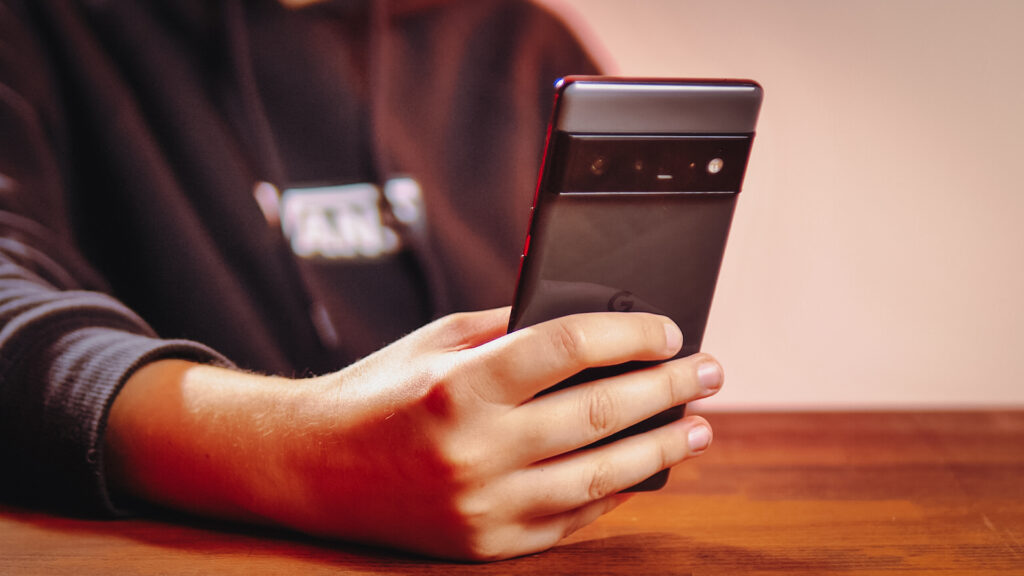The influencer Enjoyphoenix has established a paid partnership to promote « anti-radiation patches » on her Instagram account. Problem: the health benefit of these stickers is not proven. They could even be harmful.
It’s a paid partnership that will perhaps cause more headaches for Enjoyphoenix than the waves emitted by smartphones. Indeed, the famous influencer found herself promoting a product whose health benefit has so far not been scientifically demonstrated. A gadget that is presented as capable of reducing or canceling symptoms attributed to the waves, precisely, such as headaches.

What happened ? On the evening of May 4, 2022, the French youtuber and instagrammer, who is called Marie Lopez in civilian life, shared several “stories” on her personal account. These “stories”, which are ephemeral content visible for 24 hours, are notably devoted to a Swiss company, Fazup, whose specialty is to manufacture “anti-wave patches”. Or at least, patches presented as such.
In all, Enjoyphoenix has shared nine stories on her Instagram account in which she praises the supposed merits of this patch. » Fazup is not a simple sticker, but a passive antenna that sticks precisely to the antenna of your mobile thanks to the installation tool provided. It regulates the emission of mobile waves at the source, and reduces your exposure, but does not eliminate 100% of the waves “, can we for example read in an insert accompanying the words of the influencer.
Everything else is up to date. The problem, unfortunately for Enjoyphoenix as well as for Internet users who wrongly place their trust in this paid partnership (the amount of the contract between the influencer and Fazup is not public. We only know that the Internet users she manages to convert will have entitled to a 20% reduction by using a code on the merchant’s site), it is that these patches have not demonstrated their effectiveness.
It is normal for smartphones to emit waves, since they are wireless links
First, an observation: it should be remembered that since smartphones are not physically connected by a wire to a relay antenna or an Internet box, they are obliged to communicate differently. This is where radio waves come into play: it is normal for smartphones to send and receive them, since these are wireless telecommunications. An anti-radiation patch that would also block 100% of the waves would also pose a few small problems for communication.
These waves make up what is called the electromagnetic spectrum. It is an invisible and impalpable field that surrounds and penetrates us. It is found everywhere. Light is part of it. X-rays too, as well as ultraviolet, infrared and, of course, radio waves. It is thanks to this spectrum that we can have wireless links (Wi-Fi, Bluetooth, 4G, 5G, etc.). These waves have various specificities (frequency, energy, wavelength).
These established prolegomena, do these patches have any health benefits? The answer ranges from a firm and massive “no” and “the health benefit has not been demonstrated”, in the best case, to “it could even prove to be rather harmful” in the worst. Anti-radiation equipment in general and Fazup patches in particular have already been the subject of several verification and demystification publications. In short, it’s useless, and it rides on a fear and a lack of knowledge of tech.

In a FAQ devoted to public exposure to waves, the National Frequency Agency (whose mission is to verify that the level of exposure complies with the regulations) explains that » anti-radiation devices intended to be placed on or near the antenna of the mobile phone do not show significant protection efficiency for all the mobile phones and frequency bands tested. »
It should be noted that this agency has the capacity to identify any excess or deviation from the levels set by the regulations. When this occurs, it can require the manufacturer to adjust the transmission power by updating (this happens from time to time). It can also require the withdrawal from the market of certain products, including a smartphone. The Razer Phone 2 had been recalled because it was emitting too many waves.
The National Frequency Agency also refers to the work carried out in 2013 by the National Agency for Food, Environmental and Occupational Health Safety (Anses) on the subject. Thirteen devices had been tested and the conclusions were very clear: “ Anti-radiation devices intended to be placed on or near the antenna of the mobile telephone do not show significant protection efficiency for all the mobile telephones and the frequency bands tested. No conclusion can therefore be drawn as to their effectiveness in reducing the level of DAS. »
It was on the basis of these conclusions that the General Directorate for Competition, Consumer Affairs and Fraud Prevention (DGCCRF) conducted a survey in 2015 on the conditions for marketing « anti-radiation » devices for mobile phones. The sale of this equipment often comes with multiple claims that need to be verified. Most of them have no basis.
Smartphones are subject to very specific regulatory thresholds to preserve health
The SAR, acronym for « specific absorption rate », is a numerical indicator used to quantify the energy of the waves emitted by radioelectric equipment which is absorbed by the human body. The lower this indicator, the better. This indicator is public: it is found on the sheet of each smartphone, alongside its other technical characteristics. It allows to indicate to the public the intensity of the SAR for each model.
Several SAR thresholds exist in France and the rule is, of course, not to exceed them. The measurement is in watts per kilogram (W/kg). It is 2 W/kg for the head and for the trunk, ie the torso. It is 4 W/kg for the limbs. These measurements are made at a distance of just a few millimeters, in order to transcribe as faithfully as possible the exposure of a person in the process of telephoning, having it in a pocket or in the hand.

A question then remains: how were these limit values of 2 and 4 W/kg chosen? In fact, they come from the work of the International Commission on Non-Ionizing Radiation Protection, an international non-governmental organization made up of independent scientific experts. These values were established in 1998, but can be revised if necessary. It has already happened, without calling into question the previous framework.
By simplifying in broad strokes, the thresholds were designed in two stages. There was first an experimentation phase, to detect a thermal effect (a heating of the tissues, in clear) due to the waves is observed. Based on this observation, a regulatory limit was set. This limit is fifty times lower than what has been measured in the laboratory. This is a significant safety margin which serves to cover possible scientific uncertainties.
It is therefore on this regulatory limit, fifty times lower than what could be detected in the laboratory, that the specific absorption rate was designed. It is therefore at this level that the National Frequency Agency intervenes to adjust the signal strength with the manufacturers. The agency also has other missions, always linked to the airwaves. For example, she is very busy with 5G and Linky meters, but has not detected anything of concern, despite the concerns that may have germinated on social networks.
Clearly, the exposure of the population to waves is generally low in France. From time to time there may be atypical cases, discrepancies and threshold overruns, but these are subject to checks and corrections. In the case of laptops, this translates into software updates and, in the most serious cases, a withdrawal of the product and, sometimes, a monetary penalty against the manufacturer.
Anti-wave patches whose effectiveness is not proven and which can be counterproductive
In any case, Enjoyphoenix is not the only public figure or influence to be convinced by these anti-radiation patches. As journalist Raphaël Grably noted, Fazup was able to rely on Louise Chabat, influencer « young mothers » and daughter of actor Alain Chabat, to relay its communication. A survey by BFM TV also showed Fazup’s strategy of frightening young mothers to sell anti-radiation patches.
As the article noted from 2020, Fazup does not provide any evidence concerning the effects of its products on health. Questioned on this subject, the two founders of Fazup admitted at the time that he had not provided any proof of the health benefit of this sticker. They admitted to play half-word on the words: » We write for example that our product eliminates the feeling of headaches, not that it eliminates headaches. »
Also in 2020, Stéphane Marty, a microelectronics engineer and videographer from the Deus Ex Silicium channel, who is precisely interested in the operation of devices, by dissecting in all kinds of ways, published a video in which he analyzes and tests a Fazup patch for smartphone. And the conclusions of these measurements are far from flattering.
In fact, and this is the whole paradox of these devices presented as anti-waves: these patches even appear counterproductive, even rather harmful to health. As some of these products hinder the diffuse propagation of waves, in the course of normal operation, smartphones, noting a difficulty in hooking up a signal with the relay antenna, find themselves emitting more waves to overcome the obstacle.
This is what ANSES pointed out in its 2013 opinion. Protections which modify the radio performance of mobile telephones, for example by degrading the reception capacities, risk, under real conditions of use, to increase the level of exposure of the user. « . In other words, this type of patch does not let the waves escape naturally: on the contrary, it generates focal points, with the key being an increased intensity, which is more harmful. Absurd.


